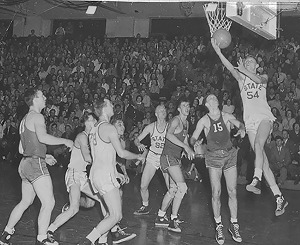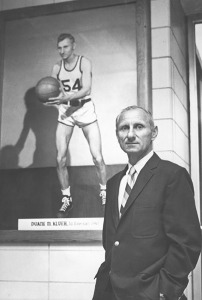Subscriber Benefit
As a subscriber you can listen to articles at work, in the car, or while you work out. Subscribe Now TERRE HAUTE—Even at 94, he’s not the oldest man to have played in the NBA. Which is OK with him because that was never a goal. In fact, it wasn’t his ambition even to play in the NBA.
TERRE HAUTE—Even at 94, he’s not the oldest man to have played in the NBA. Which is OK with him because that was never a goal. In fact, it wasn’t his ambition even to play in the NBA.
But time goes on, one thing leads to another, and the next thing you know you’ve lived a life filled with unexpected events. For Duane Klueh, that includes singular status as the oldest alum of an Indiana high school or college to have played in the NBA, a noteworthy achievement for both the quality of his talent and the quantity of his years.
He played only two seasons in the league and, frankly, most of his proudest accomplishments have occurred outside of professional basketball. Still, those two groundbreaking seasons in the infancy of the NBA have provided his most exclusive niche (the list of 90-plus NBA veterans is small and dwindling, as you might imagine) as well as his best stories. And we’re here for the stories.
First, some background.
Klueh (pronounced Klee) was a star at Terre Haute State High School (a laboratory school for Indiana State University), graduating in 1943. He entered the Navy for two years at the end of World War II, then enrolled at Indiana State. He played his first two varsity basketball seasons for Johnny Wooden, who remained a lifelong friend, and earned small college All-America honors while leading the Sycamores to second place in the NAIB tournament in 1948. He was voted MVP and Chuck Taylor, the legendary shoe guy, presented him with the trophy.
How good was Klueh? Consider that, all these years later, Indiana State has retired the numbers of just three basketball players: Larry Bird and Carl Nicks from the 1979 NCAA runner-up team and Klueh, who was the university’s all-time leading scorer when he completed his career in 1949. He still ranks seventh.
A lot of life

There was another young kid knocking around Terre Haute at that time, a high school underclassman with such obvious talent and passion that Wooden let him in through a side door to watch practice. That kid attended a lot of the home games, too, and became so enthralled with Klueh’s game he tried to imitate elements of it.
“He was something else,” Bobby “Slick” Leonard says today. “He didn’t know it, but he was an inspiration to me.”
Klueh, who lives in a senior community in Terre Haute, was an inspiration after leaving his NBA career, too. His first job in the real world was at Fowler High School near Lafayette, with an enrollment of about 100. He won three sectional titles in four years, then returned to Indiana State, where he coached basketball for 12 years and tennis for 26. As a coach, he is the university’s all-time leader in victories in both sports and left both positions voluntarily.
He taught physical education classes, too. Bird was enrolled in his tennis class, which evolved into a badminton class when the weather turned cold. Klueh had been a standout tennis player at ISU as well and played competitively for as long as his legs held up. He won singles and doubles titles in national senior tournaments into his mid-70s and played recreationally until his mid-80s.
That’s a lot of life to cram into a few paragraphs, and it all combines to make Klueh one of the most accomplished sports figures in the state today. But that’s not where his craziest stories are to be found. You have to go to the birth of the NBA for those.
First, Denver
He didn’t plan to be there for it. He had accepted a teaching and coaching position at Rockhurst University in Kansas City, Missouri, after graduating from ISU in 1949, but an out-of-the-blue offer redirected his life.
Hal Davis, general manager of the Denver franchise in the NBA, a league freshly formed by the merger of the Basketball Association of America and National Basketball League, dangled a salary of $6,000 to play for the Nuggets. That was about three times what Rockhurst was offering, so Klueh, being a practical man, loaded up his pregnant wife, Mary Alice, and boarded a train to Denver.
The Nuggets, frankly, were horrible. They would finish the season 11-51, worst among the 17 teams in the inaugural season of the NBA. Klueh’s good fortune was that he didn’t have to experience all of it personally.
He fractured his ankle in the season’s third game, at Syracuse, when he took the opening tip, planted his left foot to cut to the basket, and suffered a hairline fracture. He missed the next 11 games. He was back in plenty of time for the road trip from hell, though. It’s almost unimaginable today.
The Nuggets played a home game on Dec. 7, losing to Sheboygan to fall to 3-17. As if that weren’t bad enough, the schedule awaiting them loomed like a bad dream. Their next game was to be played in Indianapolis on the 9th, then Rochester on the 10th and Moline on the 11th. Trains weren’t going to get them where they needed to be in time, so the nine players, including player-coach Jim Darden, headed for Indianapolis in two cars following the loss to Sheboygan, five men in one and four in the other.

Klueh was fortunate to be part of the four-man contingent, riding in a Dodge convertible driven by his former ISU teammate, Bobby Royal. The car was fairly new and not too drafty, but they still had to put a sheet of cardboard in front of the radiator to help stay warm as they drove along the wind-whipped roads of Kansas, Missouri and Illinois.
They arrived in Terre Haute just short of midnight on Thursday the 8th and stopped at the home of Klueh’s mother, who had gone to bed but left out food for them. Then they were off to Indianapolis, arriving at a downtown hotel about 3 a.m.
They lost to the Olympians that night by three points before 1,600 fans at Butler Fieldhouse, a representative showing against one of the league’s better teams. But when they headed out afterward to begin the drive to Rochester, they were greeted by freezing rain that covered the roads with a sheet of ice. Their car spun a complete circle on U.S. 52 on their way north, but luckily avoided contact.
‘What happened to you?!’
After stopping in Calumet City outside of Chicago for breakfast, they continued the trek to Rochester for that night’s game against Minneapolis. They arrived shortly before tip-off. The other five players had beaten them there but two were begging off. According to the Minneapolis Star Tribune’s game story, player-coach Darden didn’t play because of a leg injury that resulted from “pushing a gas pedal all the way from Indianapolis” and Kenny Sailors sat out because he was “just plain tired.”
Another day, another game, another loss—this time by 13 points—and they were off to Moline. Klueh’s crew arrived about 4 a.m. They slept for a few precious hours and then woke up to play a 2 p.m. game. Thoroughly exhausted and fed up by this point, the Nuggets lost by 22 points to the Tri-Cities Blackhawks, who were refreshed after a three-day break in their schedule. Understandably, some of the Nuggets were a little cranky. Two near-fights broke out and three technical fouls were assessed late in the game.
Not just cranky. Smelly, too. NBA teams traveled without equipment managers in those days. Most didn’t even have one. That meant the players were responsible for washing their own uniforms on road trips. Which meant the uniforms often went unwashed, particularly on a journey as hectic as this one.
“We just put them back on, stiff as a board,” Klueh said.
There was always time for a prank, though. After the players checked into their hotel in Moline, Klueh said, a couple of the players paid a maid a few dollars to lie in bed next to one of their sleeping teammates. Then they woke him up.
“He looked around and didn’t know what he had done,” Klueh said, laughing at the memory.
Still ahead: a 900-mile drive back to Denver. When Klueh’s wife greeted him at their front door the next evening, she was horrified by the sight of the man staring back at her.
“What happened to you?!” she shrieked.
It was as if she had seen a ghost, which wasn’t far from the truth. The road trip had been the equivalent of a coast-to-coast jaunt, covering nearly 3,000 miles. They had played three games in less than three days before a combined total of fewer than 7,000 fans and lost all three.
“My wife never did get over that one,” Klueh said. “She was really angry that we had to do it. It wasn’t very good scheduling and it wasn’t good traveling.”
Back home again
Not very good scheduling was the order of the day in that era’s NBA. There was the time, for example, the Nuggets lost to Sheboygan on Christmas Day by four points. The next day, both teams boarded a DC-3 for a wind-jarred flight to Casper, Wyoming, for an exhibition game.
Yes, an exhibition game. In the middle of the season. In Casper, Wyoming. In a high school gymnasium.
Three of the Nuggets had played at the University of Wyoming, so the hope was to draw a large enough crowd to pay off some bills. Sheboygan had no incentive whatsoever to care about the game and generously succumbed by 19 points.
That detour, however, was a vacation compared to the 10-game, 15-day road trip that followed in January. The Nuggets lost nine of those games, by an average of 17.2 points, but two good things came of it for Klueh. He scored his career high of 26 points in the eighth game of the death march, at Tri-Cities. It also turned out to be his last adventure as a Nugget.
After returning to Denver and playing in a loss to the Washington Capitals, Klueh was sold to the Fort Wayne Pistons. He had balked at the Nuggets’ plan to go on a barnstorming tour after the season to try to recoup their losses, which might have had something to do with the transaction, but either way he was ecstatic when he got a call from the Pistons’ general manager and was told a uniform and a new pair of shoes would be waiting for him.
The Pistons represented a step up in class, for sure. They were a winning team, 27-20 when Klueh arrived, and qualified as a professional organization. Like, they paid $6 per day in meal money, rather than the $5 the Nuggets doled out. They even had a trainer who traveled with the team.
His first game with his new teammates happened to be in Denver against his old teammates. As bad as the Nuggets were, Pistons Coach Murray Mendenhall was so incensed to be trailing by three points at halftime that he cussed out the players in the locker room and threatened to fine them $25 each if they lost the game. That was a rude introduction for Klueh, who hadn’t even played in the first half, but he scored eight points in the second to contribute to a comeback that resulted in a 16-point victory.
The headline in the next morning’s Denver Post read, “Klueh turns villain.”
He boarded a train with his new teammates and headed to Fort Wayne for their next game. His wife and infant son caught up with him a few days later to begin a new life back in Indiana. And the stories continued to unfold.
24-second clock
Twelve games into the 1950-1951 season, the Pistons ventured to Minneapolis. Nobody in the NBA had an answer for Lakers center George Mikan, least of all the Pistons. Mikan had scored 24 and 37 points against them in the previous season’s playoff series, and it hadn’t made a bit of difference how they had gone about defending him. So, Mendenhall came up with a bold strategy.
“He said, ‘Let’s just not play tonight,’” Klueh recalled.
Mendenhall’s strategy was to play keep-away by tossing the ball around the perimeter most of the game to try to lure Mikan away from the basket and then strike for the occasional layup. The Lakers fans, more than 7,000 of them, stomped their feet and howled in protest of the defiant display. Lakers co-owner Max Winter ran down to the Pistons bench during the game and screamed at Mendenhall that he should refund every fan’s ticket cost. Unconvinced and unfettered, Mendenhall cussed him out and sent him back to his seat.
The Pistons won, 19-18, after rookie Larry Foust took an inbound pass and threw in an improbable shot over Mikan at the final buzzer.
“We were lucky to get to the dressing room,” Klueh said. “One of our players had to grab a guy by the neck and throw him down.”
That game is widely considered the primary inspiration for the NBA’s 24-second shot clock, although it took four years for the rule to be implemented. Klueh didn’t play in it because fatigue wasn’t a factor for the starters, but he was an eyewitness with a uniform and a courtside seat.
And another story to tell.•
__________
Indianapolis native Mark Montieth is a longtime newspaper reporter and freelance writer. He is the author of three books: “Passion Play: Coach Gene Keady and the Purdue Boilermakers,” “Reborn: The Pacers and the Return of Pro Basketball to Indianapolis,” and “Extra Innings: My Life in Baseball” with former Indianapolis Indians president Max Schumacher.
Please enable JavaScript to view this content.

